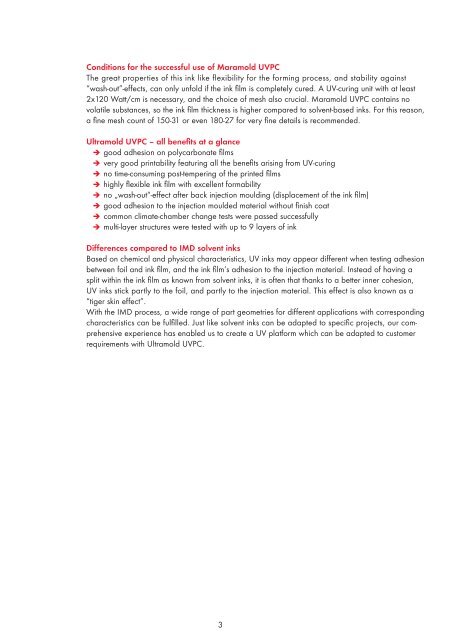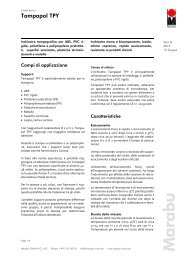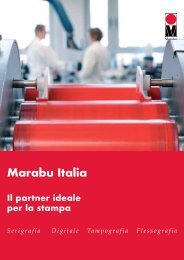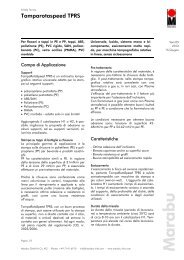New: The IMD process using UV-curable screen printing ink - Marabu
New: The IMD process using UV-curable screen printing ink - Marabu
New: The IMD process using UV-curable screen printing ink - Marabu
You also want an ePaper? Increase the reach of your titles
YUMPU automatically turns print PDFs into web optimized ePapers that Google loves.
Conditions for the successful use of Maramold <strong>UV</strong>PC<strong>The</strong> great properties of this <strong>ink</strong> like flexibility for the forming <strong>process</strong>, and stability against“wash-out”-effects, can only unfold if the <strong>ink</strong> film is completely cured. A <strong>UV</strong>-curing unit with at least2x120 Watt/cm is necessary, and the choice of mesh also crucial. Maramold <strong>UV</strong>PC contains novolatile substances, so the <strong>ink</strong> film thickness is higher compared to solvent-based <strong>ink</strong>s. For this reason,a fine mesh count of 150-31 or even 180-27 for very fine details is recommended.Ultramold <strong>UV</strong>PC – all benefits at a glance good adhesion on polycarbonate films very good printability featuring all the benefits arising from <strong>UV</strong>-curing no time-consuming post-tempering of the printed films highly flexible <strong>ink</strong> film with excellent formability no „wash-out“-effect after back injection moulding (displacement of the <strong>ink</strong> film) good adhesion to the injection moulded material without finish coat common climate-chamber change tests were passed successfully multi-layer structures were tested with up to 9 layers of <strong>ink</strong>Differences compared to <strong>IMD</strong> solvent <strong>ink</strong>sBased on chemical and physical characteristics, <strong>UV</strong> <strong>ink</strong>s may appear different when testing adhesionbetween foil and <strong>ink</strong> film, and the <strong>ink</strong> film’s adhesion to the injection material. Instead of having asplit within the <strong>ink</strong> film as known from solvent <strong>ink</strong>s, it is often that thanks to a better inner cohesion,<strong>UV</strong> <strong>ink</strong>s stick partly to the foil, and partly to the injection material. This effect is also known as a“tiger skin effect”.With the <strong>IMD</strong> <strong>process</strong>, a wide range of part geometries for different applications with correspondingcharacteristics can be fulfi lled. Just like solvent <strong>ink</strong>s can be adapted to specifi c projects, our comprehensiveexperience has enabled us to create a <strong>UV</strong> platform which can be adapted to customerrequirements with Ultramold <strong>UV</strong>PC.3






